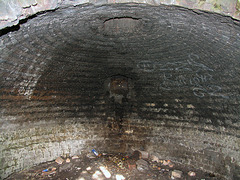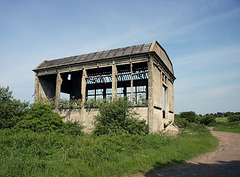tarboat's photos
Lambert, Pott Shrigley
| |
|
A very interesting brick from the collection of my friend Si.
In c1820 George Lambert and Abraham Bury started a small brickworks near Brink Farm with one kiln to fire the bricks. When they needed to expand they moved to the site in Bakestonedale.By 1848 George Lambert was operating a coal and fireclay mine with associated Pott Brickworks on the south side of the road at Bakestonedale, Pott Shrigley. Lambert was still working the Pott Shrigley coal mine in 1884 but had relinquished the firebrick works to James Hall before 1878. By 1896 all had been absorbed into the business of William Hammond on the north side of the road. This firebrick must therefore date from between 1848 and 1878.
A dying breed
| |
|
The constant stream of stone lorries on the A6 through Dove Holes still contains a good number of Foden built wagons. The numbers are dwindling though and I thought I would grab a shot of one passing by. Of course then all I saw were Scania and Volvo and after giving up this one appeared just as I was putting the camera away. In the ensuing fluster I managed to knock the switch to manual and horribly overexpose the shot. I have pulled a bit back in PS and that will have to do for today.
Upper Benllech
| |
|
Another fine bit of modelling from the recent Macclesfield Model Railway Exhibition. This one is based on the premise that the old Anglesey Central Railway had extended beyond Red Wharf Bay to reach Benllech. Sunday services actually ran on this line, unlike the original, ! :-)
Penned in
| |
|
This one is for SemmyTrailer who knows everything about British lorries. As I know little about the subject I shall leave it to him to add the details. I can say that I spotted it hiding in a Derbyshire barn whilst out and about looking at disused railways.
Coaling point
The benefits of a state education
Butterworth Hall Colliery
| |
|
Butterworth Hall Colliery was one of the largest in Milnrow in the early twentieth century. In 1869 the nine was owned by Richard and William Stott, but it was sold to Platt Brothers of Oldham. It is said to have been a very wet mine and it finally closed in 1928 after the workings became flooded. It was then purchased by Oldham Corporation for use as an underground reservoir, with upwards of a million gallons of water per day being pumped to Piethorne Reservoir, around 2 miles away. The headstocks were demolished in 1950.
The name lives on and today the shaft, which is situated just in front of the brick building in the background, continues to supply water, although the site is now run by United Utilities.
Resavica steam power
Light repairs
| |
|
|
SY 1677 undergoing maintenance in the depot at Baotou steelworks a few weeks before the end of steam at this location.
Early warning
| |
|
During the first world war there were a number of air attacks made upon the North-East coast by German aircraft. Zeppelins raided the area fifteen times between April 1915 and November 1917.
Defence against these raids was very limited and depended on knowing when aircraft were approaching and from what direction. To this end a series of listening stations were erected along the coast (and also in the south of England) in the form of 'sound mirrors'. This example, now sitting in the midst of a Redcar housing estate, and listed Grade II, was constructed by the Royal Engineers in 1916. It is about 17ft high.
The sound of the approaching aircraft was reflected off the concave surface and into a receiving trumpet mounted on a steel column in front. This was connected to the listening operator by a stethoscope and this was moved to find the part of the dish producing the most sound, which indicated the direction of approach. At least the local populace could then be given advanced warning of the impending raid.
Acoustic listening devices of various shapes were constructed along the coasts until the 1930s after which they began to be replaced by Radar.
Beehive oven - Aspen Colliery
| |
|
Interior of one of the surviving beehive coke ovens at the site of Aspen Colliery near Burnley. The colliery closed in 1922 so the survival of these ovens is remarkable.
Saltburn cliff lift
| |
|
|
The cliff lift at Saltburn-by-the-Sea is one of the oldest in the world having opened on 28th June 1884 having replaced a vertical lift that was closed in 1883 on safety grounds. This standard gauge funicular railway operates on the water balance system and raises passengers up the 120ft cliff on a gradient of 1:1.33. The bottom station for the lift is situated behind the red and cream painted buildings which are associated with the 1869 pier on which I was stood.
Tinker, Shenton & Co Limited, Makers
| |
|
Tinker, Shenton were a large manufacturer of boilers at their Hyde Boiler Works near Manchester. This is one of two Lancashire boilers installed in 1910 at the top hydraulic pump house of the Shropshire Union Railway and Canal Company at Ellesmere Port. They supplied steam at 100 p.s.i. to four engines providing hydraulic power for the dock cranes and also water supply to a nearby flour mill. Three of the engines have been restored and can be seen in steam at times, although steam is now provided by a more modern boiler situated in a separate building.
Token exchange
| |
|
Exchange of tokens as the steam service crosses a dmu at Consall station on the Churnet Valley Railway.
Tilghman's Patent Sand Blast Co
| |
|
|
There are several compressors still to be found on the various levels of the Dinorwic slate quarries. This is a particularly interesting example on the Australia level, high up in the quarry. Benjamin Chew Tilghman invented the Sandblasting process in c1870 and filed a patent for it in the United States. He began in business with his brother in Philadelphia manufacturing chilled iron shot for use in stone sawing and then moved to London where he formed 'Tilghman's Patent Sand Blast Co'. He later moved to Sheffield and then in 1879 opened a new factory in Altrincham which became the hub of the sand blasting industry in Britain. It is clear that the company produced compressors for sandblasting and these were also available for other industries such as quarrying that required compressed air for driving drills etc.
Assistance
Kilton enginehouse
| |
|
The Kilton ironstone mine installed an electric winding engine c1918 to replace a beam type steam winder with overhead drum. This enginehouse was erected immediately behind the steam winder which was to the left in this shot. In order to ensure continuity of production the winding ropes were transferred over a weekend and initially had to run through the upper part of the older building.
The shaft was 720ft deep and single deck cages holding two tubs were wound in 45 seconds. The mine closed in 1963.
Xiamiaozi yard
| |
|
SY1092 preparing a train of coal empties in the yard at Xiamiaozi on the Nanpiao Coal Railway. Steam just clings on here in 2010 but most of the work is now done by diesels.


















